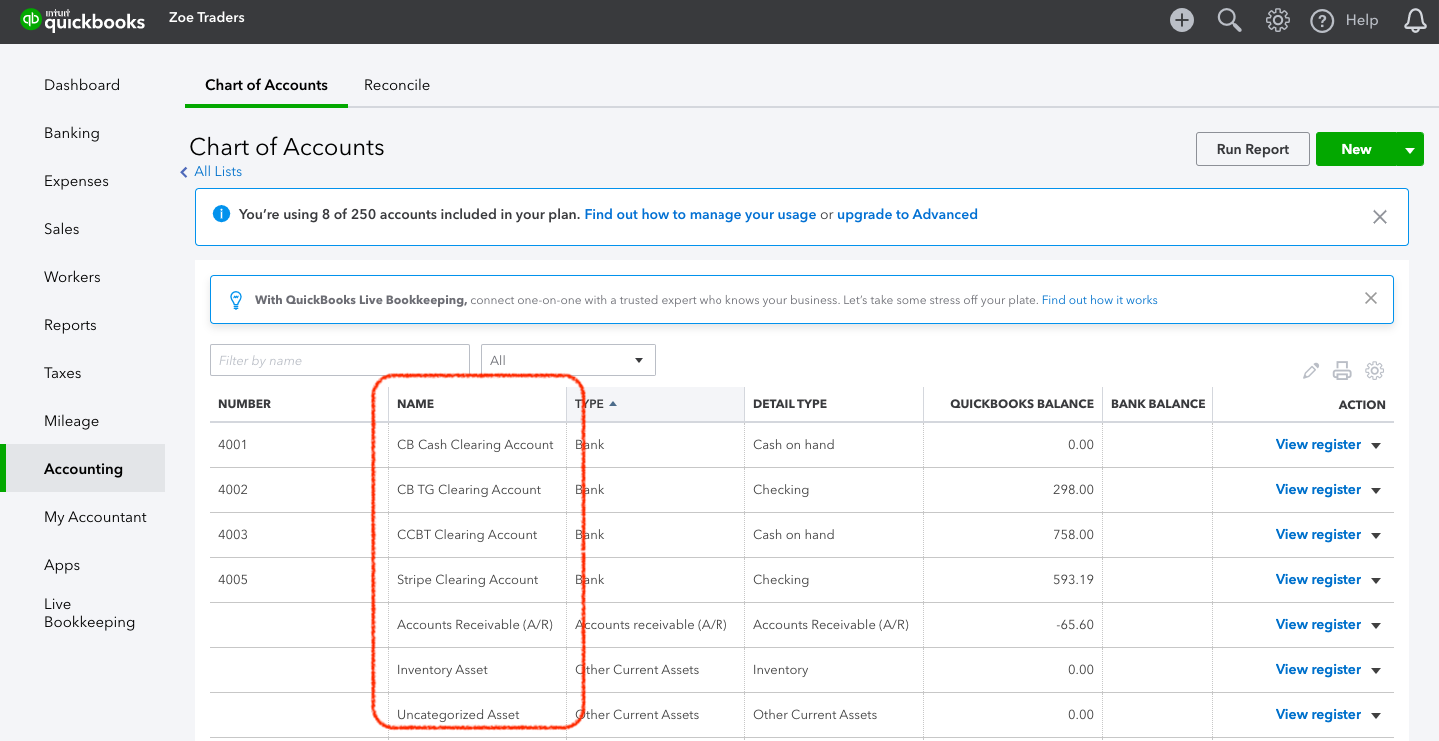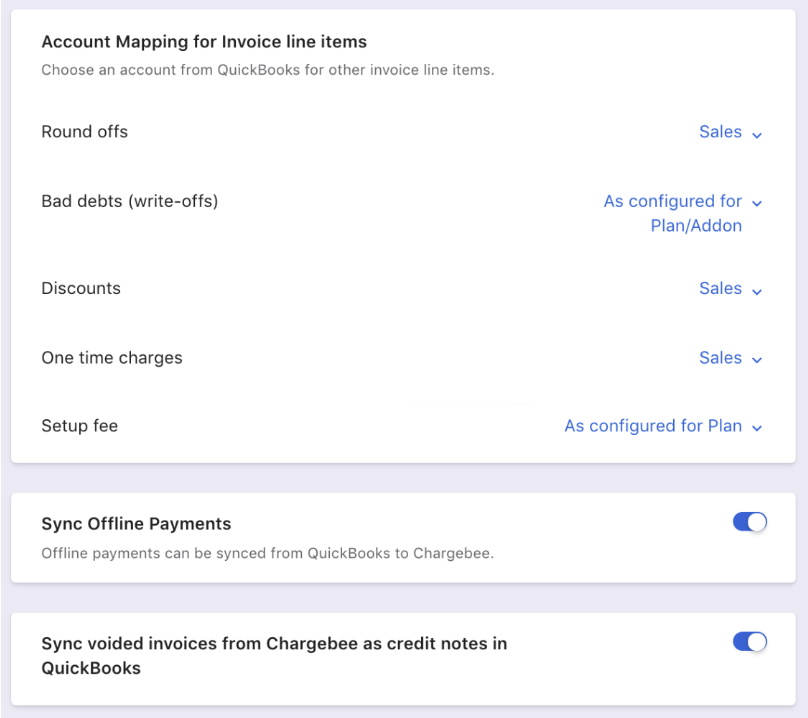By integrating your QuickBooks Online account with Chargebee, you can automate the synchronization of Invoices, Customers, and other data from Chargebee to QuickBooks, that are crucial for your financial management and analysis.
We recommend that you consult your accounting advisor before configuring the integration. You can test the integration on the Test Site before setting up the integration on the Live Site.
Ensure that you have enabled Accounting fields for QuickBooks. You can enable this by navigating to Settings > Configure Chargebee > Billing LogIQ.

Enter accounting fields for the Plans and Addons in Chargebee:
SKU - You can enter a Product name/ SKU here and this will be used as Product/ service name in QuickBooks. If a product/ service is already present in QuickBooks, Chargebee will map the product to the existing product in QuickBooks and new product will not be created.
Account Name - The Sales/Revenue GL Account Name in QuickBooks should be entered here (the field is shown in the screenshot below from QuickBooks Chart of Accounts).

Class - If Tracking category is required for Plan/ Addon, the Class can be entered here. Class tracking at customer level also is possible, contact [email protected] to set this up.
Caution!
Verify the following rules:
You can view the currencies in Chargebee by navigating to Settings > Configure Chargebee > Currencies.
Ensure that you have provided your organisation address in the Chargebee site. You can do this by navigating to Settings > Configure Chargebee > Business Profile.
Navigate to Settings > Company Settings > Advanced > Automation > Automatically Apply Credits in QuickBooks and disable the "Automatically Apply Credits" option. This is to ensure that QuickBooks does not apply credits automatically and wait for details to be synced from Chargebee.
Navigate to Settings > Company Settings > Sales > Sales Form Content in QuickBooks and enable "Custom Transaction Numbers" option, to ensure that the invoice number, credit note number is created as created in Chargebee. Additionally, if you are generating invoices manually in QuickBooks, the invoice number sequence will not be disturbed.
Best Practice
Apart from enabling "Custom Transaction Numbers" in QuickBooks, you can apply invoice/credit note numbering customization settings in Chargebee to add a dynamic prefix. This will help avoid errors on duplicate document number during the sync.
To connect to QuickBooks, go to Apps > Go to Marketplace > Accounting > QuickBooks. Click Connect and link your QuickBooks Online account.
Once you have authorized your QuickBooks account, Chargebee will check whether your plans/addons have a valid GL Account Name. Plans/addons that don't have the Account Name will be listed.
You can download the CSV file to add the accounting information for all plans and addons, by following these steps:
Once you update the details, save the file and click Upload CSV to upload the file back into Chargebee.
Once you have authorized your QuickBooks account, Chargebee will perform compatibility checks to ensure the invoices don't fail later when the invoice sync has started. The list of checks are:
a. Chargebee invoices present in QuickBooks already: If invoices from Chargebee are already created in QuickBooks manually, customers will be present as well. In order to avoid duplicates, you should map the customer records between both the systems.
You can download the CSV file, map the customers and upload the updated file in Chargebee. If there is no possibility of duplicates, you can ignore and proceed.
b. Currency check: The list of currencies enabled in Chargebee should be enabled in QuickBooks as well. For instance, if USD and GBP are configured in Chargebee, then these currencies should be available in QuickBooks too.
c. Preferences: Chargebee will check if
If you have Stripe Payment Gateway enabled, then you can choose to follow Chargebee's recommended Payment Reconciliation method.
Note:
If you do not have Stripe gateway enabled, then you will not see this option during the setup.
If you have Stripe gateway enabled but wish to handle reconciliation on your own, you can skip this step.
a. Provide Account Mapping

Caution! If you make any changes to the GL Account Name in your QuickBooks account anytime after the integration is set up, you need to update them in Chargebee as well. Failing to do so could through a sync error.
b. Sync Offline Payments
When offline payments are read from the bank statement and reconciled against open invoices in QuickBooks, these payments can be read, synced back to Chargebee. The payment_due invoices will be marked as Paid in Chargebee. You can choose to enable this feature or not.
c. Voided invoices as Credit Notes
Invoices can be voided in Chargebee, but cannot be voided in QuickBooks via API. You can choose to sync these voided invoices as Credit Notes in QuickBooks. If not enabled, you should update the invoices manually in QuickBooks, Chargebee will not void the invoices in QuickBooks.
d. Enter Tracking Categories
If you have setup Classes in QuickBooks, you can enter the tracking categories for one-time charges, setup fee, discounts and round-off.

If you are using US edition of QuickBooks (or Global edition):
Chargebee will create Tax Rates in QuickBooks automatically. Providing tax code-mapping for US is a tedious process.
If you are using a Canada, Australia, New Zealand, South Africa, Singapore edition of QuickBooks:
You can select from the list of default tax rates created in QuickBooks

| Category | Select a Tax Rate from QuickBooks |
| Sales | Select a Tax code to map all your taxable sales, for instance, New Zealand - 15% GST. |
| Exempt | Select a Tax code to map sales exempt from taxes for - Customer or Products can be exempt |
| Export | Select a Tax code to map sales to any other country outside your taxable region |
| Reverse Charge | Select a tax code for B2B sales with a valid Tax registration number |
If you are using the UK edition of QuickBooks
UK organisation in QuickBooks supports EU VAT Returns filing from within the application. QuickBooks creates default Taxes to facilitate accurate VAT Liability reporting.
While configuring taxes in Chargebee, you can select from one of the default Tax rates created in QuickBooks UK version.
Select a date from which invoices generated in Chargebee should be synced to QuickBooks.
You can choose from one of the following options:
If you choose to sync from a specific date, Invoices and related records from the specified date will only be synced to QuickBooks.
Caution!
Once the configuration is complete, you can begin with the sync. Chargebee will sync first 10 invoices only, to ensure the mapping, conventions and sync criteria align with your requirements.
We recommend that you review these invoices in QuickBooks. If the sync works as expected, you can click on the Sync All Records option and proceed or make the required changes.
QuickBooks setup is now complete.
After you run the sync, you can view the last sync details along with errors found during sync if any:

For on-demand sync, you can push data from Chargebee to QuickBooks immediately.
After setting up the integration, you can schedule to sync all the information to QuickBooks on a daily basis automatically. Invoices and related information will be synced to QuickBooks once in every 24 hrs. You can choose to disable auto-sync if required.
You can edit the configuration details provided as part of integration setup process:
You can modify the tax codes selected during the setup process. If you have added tax regions in your Chargebee settings, you can provide the new tax codes here.
In case you want to stop syncing data from Chargebee to QuickBooks, you can Unlink the integration.
Chargebee will remove/update the authentication and configuration as per the following:
For Test Sites:
For Live Sites:
You can choose to retrieve the offline payments into Chargebee(or not), with the ‘Sync Offline Payments' option.
Caution!
When Sync Offline Payments is not enabled and you make an offline payment in QuickBooks against a payment due invoice in Chargebee, you would have to manually record a payment against the invoice in Chargebee as well. Failing to do so could throw an error message "The invoices linked to this payment do not match". You can manually correct this in QuickBooks.
With the Sync Offline Payments option enabled, Chargebee will read the transaction in QuickBooks, retrieve the transaction and mark the invoice as PAID, so you need not record a payment in Chargebee manually.
Note:
The exchange rate applied in QuickBooks is not imported into Chargebee when the offline payment is imported.

Note:
Only applicable for sites which have Stripe gateway configured.
Chargebee recommends the following payment reconciliation method:
Read more about Chargebee's reconciliation process.